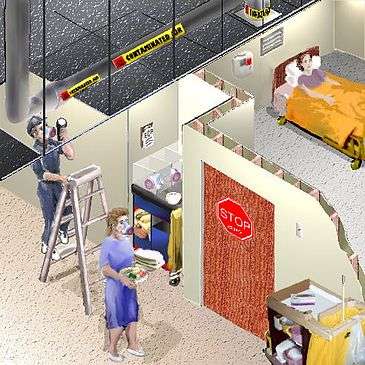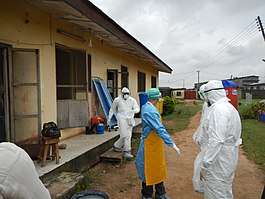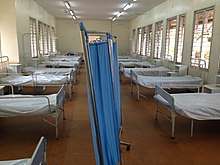Isolation (health care)
In health care facilities, isolation represents one of several measures that can be taken to implement infection control: the prevention of contagious diseases from being spread from a patient to other patients, health care workers, and visitors, or from outsiders to a particular patient (reverse isolation). Various forms of isolation exist, in some of which contact procedures are modified, and others in which the patient is kept away from all others. In a system devised, and periodically revised, by the U.S. Centers for Disease Control and Prevention (CDC), various levels of patient isolation comprise application of one or more formally described "precaution".

Isolation is most commonly used when a patient is known to have a contagious (transmissible person-to-person) viral or bacterial illness.[1] Special equipment is used in the management of patients in the various forms of isolation. These most commonly include items of personal protective equipment (gowns, masks, and gloves) and engineering controls (positive pressure rooms, negative pressure rooms, laminar air flow equipment, and various mechanical and structural barriers).[2] Dedicated isolation wards may be pre-built into hospitals, or isolation units may be temporarily designated in facilities in the midst of an epidemic emergency.
Importance
Contagious diseases can spread to others through various forms. Four types of infectious disease transmission can occur: (1) contact transmission, which can be through direct physical contact, indirect contact through fomites, or droplet contact in which airborne infections spread short distances, (2) vehicular transmission, which involves contaminated objects, (3) airborne transmission, which involves spread of infectious particles through air, and (4) vector transmission, which is spread through insects or animals.[3] Depending on the contagious disease, transmission can occur within a person's home, school, worksite, health care facility, and other shared spaces within the community. Even if a person takes all necessary precautions to protect oneself from disease, such as being up-to-date with vaccines and practicing good hygiene, he or she can still get sick. Some people may not be able to protect themselves from diseases and may develop serious complications if they contract the disease. Therefore, disease isolation is an important infection prevention and control practice used to protect others from disease.[4] Disease isolation can prevent healthcare-acquired infections of hospital-acquired infections (HCAIs), reduce threats of antibiotic resistance infections, and respond to new and emerging infectious disease threats globally.[5]
Types of precautions
The U.S. Centers for Disease Control and Prevention (CDC) created various levels of disease isolation (also described "precaution"). These precautions are also reviewed and revised by the CDC.[6]
Universal/standard
Universal precautions refer to the practice, in medicine, of avoiding contact with patients' bodily fluids, by means of the wearing of nonporous articles such as medical gloves, goggles, and face shields. The practice was widely introduced in 1985–88.[7][8] In 1987, the practice of universal precautions was adjusted by a set of rules known as body substance isolation. In 1996, both practices were replaced by the latest approach known as standard precautions. Use of personal protective equipment is now recommended in all health settings.
Transmission-based
Transmission-based precautions are additional infection control precautions – over and above universal/standard precautions – and the latest routine infection prevention and control practices applied for patients who are known or suspected to be infected or colonized with infectious agents, including certain epidemiologically important pathogens. The latter require additional control measures to effectively prevent transmission.[9][10]There are three types of transmission-based precaution:
- Contact precautions are intended to prevent transmission of infectious agents, including epidemiologically important microorganisms, which are spread by direct or indirect contact with the patient or the patient's environment.
- Droplet precautions are intended to prevent transmission of pathogens spread through close respiratory or mucous membrane contact with respiratory secretions.
- Airborne precautions prevent transmission of infectious agents that remain infectious over long distances when suspended in the air (e.g., rubeola virus [measles], varicella virus [chickenpox], M. tuberculosis, and possibly SARS-CoV).
Isolation
According to the CDC, isolation is used to protect the general public from possible exposure of a contagious disease. Isolation is the act of separating a sick individual with a contagious disease from health individuals without that contagious disease.[11]
Special equipment is used in the management of patients in the various forms of isolation. These most commonly include items of personal protective equipment (gowns, masks, and gloves) and engineering controls (positive pressure rooms, negative pressure rooms, laminar air flow equipment, and various mechanical and structural barriers). Dedicated isolation wards may be pre-built into hospitals, or isolation units may be temporarily designated in facilities in the midst of an epidemic emergency.[12]
Isolation should not be mistaken as the same as quarantine or biocontainment. Quarantine is the compulsory separation and confinement, with restriction of movement, of healthy individuals or groups who have potentially been exposed to an agent to prevent further infections should infection occur. Biocontainment refers to laboratory biosafety in microbiology laboratories in which the physical containment (BSL-3, BSL-4) of highly pathogenic organisms is accomplished through built-in engineering controls.[13]
Many forms of isolation exist.
Strict isolation
Strict isolation is used for diseases spread through the air and in some cases by contact.[2] Patients must be placed in isolation to prevent the spread of infectious diseases.[14] Those who are kept in strict isolation are often kept in a special room at the facility designed for that purpose. Such rooms are equipped with a special lavatory and caregiving equipment, and a sink and waste disposal are provided for workers upon leaving the area.[15]
Contact isolation
Contact isolation is used to prevent the spread of diseases that can be spread through contact with open wounds. Health care workers making contact with a patient on contact isolation are required to wear gloves, and in some cases, a gown.
Respiratory isolation
Respiratory isolation is used for diseases that are spread through particles that are exhaled.[2] Those having contact with or exposure to such a patient are required to wear a mask.
Reverse isolation
.jpg)
Reverse isolation is a way to prevent a patient in a compromised health situation from being contaminated by other people or objects. It often involves the use of laminar air flow and mechanical barriers (to avoid physical contact with others) to isolate the patient from any harmful pathogens present in the external environment.[17]
High isolation
High isolation is used to prevent the spread of unusually highly contagious, or high consequence, infectious diseases (e.g., smallpox, Ebola virus). It stipulates mandatory use of: (1) gloves (or double gloves if appropriate), (2) protective eyewear (goggles or face shield), (3) a waterproof gown (or total body Tyvek suit, if appropriate), and (4) a respirator (at least FFP2 or N95 NIOSH equivalent), not simply a surgical mask.[18] Sometimes negative pressure rooms or powered air-purifying respirators (PAPRs) are also used.
Isolation of health care workers

Disease isolation is relevant to the work and safety of health care workers. Health care workers may be regularly exposed to various types of illnesses and are at risk of being getting sick. Disease spread can occur between a patient and a health care worker, even if the health care workers takes all necessary precautions to minimize transmission, including proper hygiene and being up-to-date with vaccines. If a health care gets sick with a communicable disease, possible spread may occur to other health care workers or susceptible patients within the health care facility. This can include patients with a weakened immune system and may be at risk for serious complications.[19]
Health care workers who become infected with certain contagious agents may not be permitted to work with patients for a period of time. The Occupational Safety and Health Administration (OSHA) has implemented several standards and directives applicable to protecting health care workers from spread of infectious agents. These include blood borne pathogens, personal protective equipment, and respiratory protections. The CDC has also released resource for health care facilities to assist in assessing and reducing risk for occupational exposure to infectious diseases. The purpose of these standards and guidelines are to prevent the spread of disease to others in a health care facility.[20]
Consequences
Disease isolation is rarely disputed for its importance in protecting others from disease. However, it is important to consider the consequences disease isolation may have on an individual. For instance, patients may not be able to receive visitors, and in turn, become lonely. Patients may experience depression, anxiety, and anger.[21] Small children may feel their isolation is a punishment.[22] Staff may need to spend more time with patients. Patients may not be able to receive certain types of care due to the risk that other patients may become contaminated. This includes forms of care that involve use of equipment common to all patients at the facility, or that involve transporting the patient to an area of the facility common to all patients. Given the impact of isolation on patients, social and emotional support may be needed.[23]
Although a majority of health care professionals advocate for disease isolation as an effective means of reducing disease transmission. However, some health care professionals are concerned with implementing such control protocols given the possible negative consequences on patients. Patients isolated with Methicillin Resistant Staphylococcus Aureus (MRSA) can also be negatively impacted by having less documented care/bedside visits from attending and residents.[24]
Ethics
Disease isolation serves as an important method to protect the general community from disease, especially in a hospital or community-wide outbreak. However, this intervention poses an ethical question on rights of the individual versus rights of the general community.[25]

Infectious diseases, including isolation precaution measures, are generally not considered a primary topic of importance in the field of bioethics in comparison to other topics such as euthanasia, assisted reproduction, and genetics. Possible reasons as to why infectious diseases are not viewed as a primary topic in medical ethics include the following: bias for topics that are more high-tech, wealthy-world topics such as euthanasia and assisted reproduction, blinding optimism that infectious diseases are no longer a threat because of the success of antibiotics and vaccines, and the labeling of "other" among certain infectious diseases such as AIDS, tuberculosis, Ebola, etc.[26]
In cases of disease outbreaks, isolation can be argued as an ethical and necessary precaution for protecting the community from further disease transmission. This can be seen during the 2014 Disneyland measles outbreak and 2014 Ebola outbreak. This can be justified using felicific calculus to predict the outcomes (consequences) of moral action between the individual rights versus the rights of the general public during disease isolation. This justifies that disease isolation is most likely to result in the greatest amount of positive outcomes for the largest number of people.[27]
Disease isolation can also be justified as a morally legitimate ethical practice in public health based on the reciprocal relationship between the individual and the state. The individual is obligated to protect others by preventing further spread of disease, respect the instructions from public health authorities and sequester themselves in their homes and not attend public gatherings, and act as a first responder (if a healthcare professional) by providing services to protect and restore public health. The state, on the other hand, is obligated to provide support to individuals burdened as a result of restrictive measures (e.g. compensation for missed work, providing access to food and other necessities for those quarantined and isolated, assistance for first responders to balance personal/professional obligations), ensure several legal protections are in place for those subjected to restrictive measures, and communicate all relevant information regarding the necessity of restriction.[28]
References
- Lawrence J; May D (2003). Infection control in the community. Elsevier Health Sciences. p. 136. ISBN 978-0-443-06406-7.
- Uys LR (1999). Fundamental nursing. Pearson South Africa. p. 249. ISBN 978-0-636-04208-7.
- Walker HK, Hall WD, Hurst JW, McCue JD (1990). Walker HK, Dallas W, Willis J (eds.). The Contagious Patient. Clinical Methods: The History, Physical, and Laboratory Examinations (3rd ed.). Butterworths. ISBN 978-0-409-90077-4. PMID 21250179.
- Swanson J, Jeanes A (June 2011). "Infection control in the community: a pragmatic approach". British Journal of Community Nursing. 16 (6): 282–8. doi:10.12968/bjcn.2011.16.6.282. PMID 21642912.
- Gammon J, Hunt J (February 2018). "A review of isolation practices and procedures in healthcare settings". British Journal of Nursing. 27 (3): 137–140. doi:10.12968/bjon.2018.27.3.137. PMID 29412028.
- "Standard Precautions for All Patient Care | Basics | Infection Control | CDC". www.cdc.gov. 2019-03-25. Retrieved 2019-05-01.
- Centers for Disease Control (CDC) (June 1988). "Update: universal precautions for prevention of transmission of human immunodeficiency virus, hepatitis B virus, and other bloodborne pathogens in health-care settings". MMWR. Morbidity and Mortality Weekly Report. 37 (24): 377–82, 387–8. PMID 2836717.
- Centers for Disease Control (CDC) (November 1985). "Recommendations for preventing transmission of infection with human T-lymphotropic virus type III/lymphadenopathy-associated virus in the workplace". MMWR. Morbidity and Mortality Weekly Report. 34 (45): 681–6, 691–5. PMID 2997587.
- Siegel JD, Rhinehart E, Jackson M, Chiarello L (December 2007). "2007 Guideline for Isolation Precautions: Preventing Transmission of Infectious Agents in Health Care Settings". American Journal of Infection Control. 35 (10 Suppl 2): S65–164. doi:10.1016/j.ajic.2007.10.007. PMID 18068815.
- {{cite book |title=Infection prevention and control of epidemic- and pandemic-prone acute respiratory diseases in health care, WHO Interim Guidelines |date=2007 |page=53 ||
- "Quarantine and Isolation | Quarantine". Centers for Disease Control and Prevention. 2018-10-03. Retrieved 2019-05-01.
- Fundamental Nursing - Textbook (Paperback). Leana Uys. 2003. ISBN 978-0-636-04208-7. Retrieved 2019-05-01.
- "Quarantine and Isolation | Quarantine". Centers for Disease Control and Prevention. 2018-10-03. Retrieved 2019-05-01.
- White L (2004). Foundations of nursing. Cengage Learning. p. 757. ISBN 978-1-4018-2692-5.
- Lawrence J, May D (2003). Infection control in the community. Elsevier Health Sciences. p. 136. ISBN 978-0-443-06406-7.
- Blake M (17 October 2014). "The private jet NOBODY wants to fly on: Inside the air ambulance used to transport Ebola victims around America". Daily Mail (UK). Retrieved 26 October 2014.
- Tamaroff MH, Nir Y, Straker N (1986). "Children reared in a reverse isolation environment: effects on cognitive and emotional development". J. Autism Dev. Disord. 16 (4): 415–424. doi:10.1007/bf01531708. PMID 3804957.
- Puro V, Fusco FM, Lanini S, Nisii C, Ippolito G (April 2008). "Risk management of febrile respiratory illness in emergency departments" (PDF). The New Microbiologica. 31 (2): 165–73. PMID 18623980.
- "WHO | Infection prevention and control". WHO. Retrieved 2019-05-01.
- "Safety and Health Topics | Healthcare - Infectious Diseases | Occupational Safety and Health Administration". www.osha.gov. Retrieved 2019-05-01.
- Furuno JP, Krein S, Lansing B, Mody L (April 2012). "Health care worker opinions on use of isolation precautions in long-term care facilities". American Journal of Infection Control. 40 (3): 263–6. doi:10.1016/j.ajic.2011.03.019. PMC 3526888. PMID 21784557.
- Gostin LO (March 2015). "Law, ethics, and public health in the vaccination debates: politics of the measles outbreak". JAMA. 313 (11): 1099–100. doi:10.1001/jama.2015.1518. PMID 25675396.
- Gammon J, Hunt J (January 2018). "Source isolation and patient wellbeing in healthcare settings". British Journal of Nursing. 27 (2): 88–91. doi:10.12968/bjon.2018.27.2.88. PMID 29368561.
- Masse V, Valiquette L, Boukhoudmi S, Bonenfant F, Talab Y, Carvalho JC, Alarie I, Carrier N, Farand P (2013). "Impact of methicillin resistant Staphylococcus aureus contact isolation units on medical care". PLOS ONE. 8 (2): e57057. Bibcode:2013PLoSO...857057M. doi:10.1371/journal.pone.0057057. PMC 3581535. PMID 23451144.
- Aita M, Ragland T (2015-01-01). "Ebola Scare and Measles Resurgence: Mandatory Isolation/quarantine and Vaccination". Online Journal of Health Ethics. 11 (2). doi:10.18785/ojhe.1102.02. ISSN 1551-4218.
- Selgelid MJ (June 2005). "Ethics and infectious disease". Bioethics. 19 (3): 272–89. doi:10.1111/j.1467-8519.2005.00441.x. PMID 16167406.
- Aita MD, Mark C, Ragland MA, Takeem T (2015). "Ebola Scare and Measles Resurgence: Mandatory Isolation/quarantine and Vaccination". Online Journal of Health Ethics. 11 (2): 2. doi:10.18785/ojhe.1102.02.
- Viens AM, Bensimon CM, Upshur RE (2009-06-01). "Your Liberty or Your Life: Reciprocity in the Use of Restrictive Measures in Contexts of Contagion". Journal of Bioethical Inquiry. 6 (2): 207–217. doi:10.1007/s11673-009-9149-2.